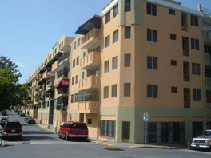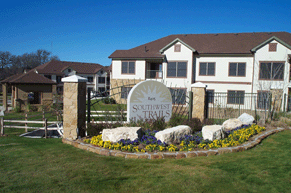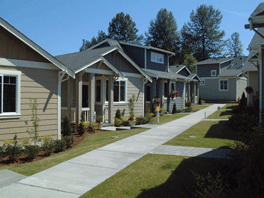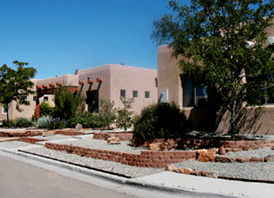|
 |
Former
HUD Chief of Staff Robert L. Woodson, Jr. |
On June 29, 2005, HUD Secretary Alphonso Jackson announced 14
winners of the first annual Robert L. Woodson, Jr. Award.
Named in honor of the former Department Chief of Staff, HUD
is making this award to recognize communities that have taken
on a leadership role in the effort to increase access to affordable
housing for American families through regulatory reform. Each
of the Woodson Award recipients has demonstrated creativity
and institutional foresight in arriving at reforms that are
bringing about an increased supply of affordable housing in
their respective jurisdictions. Strategies employed by the winning
localities most often involve multiple reforms that are part
of a larger strategy of regulatory barrier removal.
According to Secretary Jackson, “It's important to
recognize and reward communities that assume a leadership
role in encouraging the production of affordable housing."
He went on to say that, "Across this great nation, local
communities are removing barriers to affordable housing and
opening more doors to homeownership for hard working families."
These awards are being granted through the America’s
Affordable Communities Initiative (AACI), which was launched
by HUD in June 2003. Many of the winning reform strategies
and cost containment practices can be found right here on
HUD’s Regulatory Barriers Clearinghouse (www.regbarriers.org).
Reform Gets Affordable Housing on the Ground
As a result of reducing unnecessary and inhibitive regulations,
the Robert L. Woodson, Jr. Award communities have all seen
dramatic increases in affordable housing construction. Within
the 14 winning communities, nearly 14,000 affordably priced
units have been completed since the inception of their respective
regulatory reform programs. Many communities increased their
development of affordable housing by as much as 40 percent.
Since its program’s inception in 2001, Austin, Texas
has completed almost 4,000 affordably priced single- and multi-family
units. Through its regulatory reforms, Carolina, Puerto Rico
increased its affordable housing production from 400 units
between 1992 and 2000 to 1,000 units between 2001 and 2004.
In Santa Fe, New Mexico, nearly 16 percent of all new homes
built in the last decade were affordable, while in Grand Forks,
North Dakota, 57 percent of the new developments since 2002
have met affordable housing target prices. Many of the new
affordable developments were built by the private sector with
only local regulatory and related incentives.
Diversity of Winners
The winners of this year's Robert L. Woodson, Jr. Award are:
- Austin, Texas
- Carolina, Puerto Rico
- Chicago, Illinois
- Cincinnati, Ohio
- Town of Corte Madera, California
- Fitzgerald, Georgia
- Fort Collins, Colorado
|
|
|
Representing eleven states and one U.S. territory, the 14
winners reflect a broad spectrum of America’s communities.
The winning communities vary in size from just 9,000 people
to more than 3 million people. Local median incomes vary from
roughly $26,000 to $100,000 a year, and median house values
differ from approximately $52,000 to close to one million
dollars. Ranging from densely populated urban and metropolitan
areas to small towns in wealthy suburban counties to small
cities in rural areas, the communities honored by these awards
reflect a true cross-section of the American demographic.
Each community initiated a variety of regulatory reforms
to address different issues, but the award recipients all
shared one common problem: a lack of affordable housing for
their growing populations. Many communities, such as Austin,
San Antonio, Chicago, Orlando, and Oxnard (a fast-growing
county outside of Los Angeles) have faced a sharp increase
in population, and were struggling to accommodate the increasing
demand for housing. Others, such as Fitzgerald, GA and Cincinnati,
OH were faced with decaying neighborhoods and older housing
stock that needed significant investment in order to be repaired.
The solutions implemented by these communities addressed their
need to consolidate the permitting process into a “one
stop” development center and revise outdated zoning
standards. Recognizing that there was no single solution to
the variety of housing needs faced in each community, many
communities instituted a series of methods to address a wide
range of issues.
This diversity of communities and reforms demonstrates that
regulatory change is something that virtually any city can
achieve. Regardless of size and economic status, these cities
and counties have all succeeded in increasing affordable housing
through regulatory reform.
Problems Addressed
 |
| Multi-family
housing construction in Carolin, Puerto Rico |
In creating a regulatory environment that’s conducive
to affordable housing, each community faced its own underlying
set of problems. For example, after devastating floods in
1997 in Grand Forks, ND city officials created a “tool
box” of incentives to stimulate re-growth and the construction
of affordable homes, using measures that included an infill
program. The Town of Corte Madera, CA faced surging demand
for new housing and soaring prices. Carolina, PR and King
County, WA were dealing with slow permitting and review processes
that hindered development and proved too restrictive. In Fort
Collins, CO and Santa Fe, officials had already been working
for over a decade to address regulatory barriers and affordable
housing shortages. Following on the successes achieved through
favorable changes in zoning policies and the creation of an
affordable housing task force, both cities were looking for
additional solutions to rising population and housing costs
arising out of tourism and the increasing popularity of these
areas as relocation destinations.
Types of Reforms Initiated
Many of the reforms that communities undertook fall into
three broad categories:
Some communities also implemented the following changes:
Administrative Reforms
 |
| Affordable
apartment building in Carolina, Puerto Rico |
One of the most popular reforms undertaken by those submitting
applications to the inaugural AACI Woodson Award competition
in 2005 is administrative streamlining. Austin conducts fast-track
reviews of proposed developments that feature affordable housing,
and has a facilitation and resolution process to address any
problems identified along the way. Carolina, PR restructured
its planning and permitting process and established specific
timetables for each approval. Cincinnati has a One-Stop Development
Center to coordinate all permitting and processing, and to
provide builders with a single point of contact. The city
also has a cooperative pre-development meeting process that
involves all agencies in the resolution of all development
issues at one time.
Another multi-tiered approach can be found in The Town of
Corte Madera, CA, where officials have streamlined the environmental
review process, reduced permitting time for mixed-use projects,
and decreased the amount of time needed to secure approval of
accessory units.
 |
Affordable
housing rehabilitation over commercial property in Chicago,
Illinois |
And in Fitzgerald, GA, there are flexible land development standards
with streamlined approvals provided at the staff level. Fitzgerald
has also implemented batch processing of building permits. Fort
Collins, CO has priority processing for affordable housing developments,
and has instituted a 120-day target date for final review. To
further expedite the process, additional staff has been assigned
to conduct conflict resolution in the development review process.
Fort Collins now only requires “sketch plans” to
make land use decisions.
Heading north, Grand Forks, ND has instituted flexible, easy
to obtain zoning variances. King County, WA permits accessory
units on all lots over 10,000 square feet, streamlined environmental
requirements for small developments, and offers pre-approvals
of commonly used house plans. Orlando implemented a public/private
cooperative planning process for fast-track approval through
the development review process. Oxnard, CA provides for development
approvals at the administrative staff level if projects are
consistent with the city’s plans. Meanwhile, Santa Fe
accelerates the processing of housing developments that include
at least 25 percent affordably priced housing. And just north
of New York City, White Plains has a coordinated review process
chaired by the Mayor’s Office in which all city departments
conduct expedited reviews of proposed developments as a team.
Fee Waiver and Reduction Reforms
 |
Affordable
single-family subdivision in Cincinnati, Ohio |
Another common thread shared by most of the communities winning
awards this year has been reforms aimed at reducing the impact
that local government fees have on the cost of developing
affordable housing. Austin provides for fee waivers based
on the amount of affordably priced housing in a given development
proposal. Carolina, Chicago, and Fitzgerald waive permitting
fees for affordable housing developments, while Corte Madera
waives most fees for affordable housing created in their Affordable
Housing Mixed Use District. Fort Collins delays the payment
of impact fees until occupancy, and provides impact fee rebates
– especially for affordable rental housing. It also
provides inspection, right of way, and street cut fee exemptions
for affordable development. Grand Forks waives the usual 50
percent developer contribution for infrastructure and defers
special assessments imposed on buyers of affordable housing.
 |
Single-family
housing development in Oxnard, California |
Orlando offers relief from a number of fees that the city
normally requires, and provides for reimbursement of sewer
and transportation fees to developers of affordable homes.
It also provides major discounts on school impact fees and
reduced transportation capacity fees for affordable homes.
Orlando also reduces and, in some cases, waives land development
fees.
Back on the West Coast, Oxnard waives or reduces most development
fees for infill housing – regardless of income –
and defers or waives development fees if a developer will
agree to sell or lease 10 percent of the units to very low-income
or 20 percent to low-income households. San Antonio waives
impact fees on all the new affordable housing developments
in specific neighborhoods and exempts these communities from
building permit and platting fees. Santa Fe waives or reduces
various impact, processing, and permitting fees for affordable
housing developments. The city also exempts these developments
from water utility expansion charges and related water utility
building requirements.
Zoning and Land Use Reforms
 |
Southwest
Trails Apartment Complex in Austin, Texas |
Most of the winning communities have also adjusted local
zoning code provisions to encourage the development of affordable
housing, and have revised their development requirements to
reduce costs. Austin reviews all proposed code amendments,
rule changes, neighborhood plans, and development fees for
their impact on housing affordability. Chicago offers density
bonuses for affordable housing in Chicago’s booming
central area, and provides an array of incentives, including
density bonuses for market rate condominium and townhouse
developments that include affordably priced units for moderate-income
families. Cincinnati has developed a new zoning code that
allows 2,000 and 4,000 square foot lots in older neighborhoods,
permits clustered housing, and provides for reduced requirements
for side yards and setbacks.
Corte Madera created an Affordable Housing Mixed Use District
where the city can triple maximum densities, reduce parking
requirements, and increase commercial space in buildings with
affordable housing. Other reforms incorporated in the Corte
Madera code include a high density land designation that permits
25 dwelling units per acre, three high density zones requiring
that 50 percent of units be affordable, and reduced parking
standards for all affordable housing. Fitzgerald allows manufactured
housing (as of right) in most residential districts, subject
to site and design standards, and waives or adjusts setback,
side, and other development standards. Fitzgerald allows manufactured
housing, as of right, in most residential districts, subject
to site and design standards, and waives or adjusts, as needed,
setback, side and other development standards. Fort Collins
provides density bonuses and reduces builder bonding and landscaping
requirements for affordable housing. It also allows reductions
of street widths, right-of-way, and sidewalk widths. Grand
Forks offers relaxed land development requirements by requiring
narrower road widths and road right of way dedications. The
city has also reduced minimum lots sizes.
 |
Single-family
house in Orlando, florida |
In Washington State, King County has instituted a number
of land use reforms. The county has eliminated most minimum
lot sizes and has established a unique requirement for minimum
densities. It also now allows multifamily housing in many
formerly single-family residential areas and mixed uses in
many residential areas. The county also revised the county’s
zoning ordinance to provide for townhomes, zero-lot-line development,
and small cottage housing.
Orlando provides density bonuses for affordable housing and
now has flexible, less costly land development standards.
Oxnard provides density bonuses in exchange for the provision
of affordable housing, and waives or adjusts development standards
if a significant number of lower income housing units are
part of the development. San Antonio and Santa Fe grant density
bonuses for the development of affordably priced housing.
Santa Fe has also reduced lot sizes, increased lot coverage,
and provided greater opportunities for appropriately designed
HUD-Code housing. The city also eased code requirements to
allow accessory units. On a similar tack, White Plains has
enacted a comprehensive reform of its zoning ordinance with
height and density incentives available throughout the city
for both “workforce” and "below middle-income”
housing and doubled allowable densities for low-income housing
in targeted neighborhoods. To further encourage affordable
home production, White Plains has also modified its building
codes to reduce costs.
Tax Reform Policies
 |
| Multifamily
housing development in Fort Collins, Colorado |
Two of the communities that won awards during the first
AACI process used local tax policies to promote the
development of affordable housing. Fort Collins provides
sales and use tax rebates on materials to affordable
housing builders. Grand Forks has a two-year property
tax exemption for the first $75,000 of value and a three-year
property tax exemption for increased values from rehabilitation.
|
Land Utilization
 |
Single-family
housing development in King County, Washington |
In addition to reforming regulations to promote the development
of affordable housing, several of the winning communities
have provided public property to developers who would
create affordable housing. Austin makes surplus, city-owned
land available to a non-profit housing organization at
below-market rates for the development of affordably priced
housing. Carolina has an inventory of all available Commonwealth
and city-owned land, and releases some of this land to
lower development costs. Fitzgerald uses redevelopment
authority to clear and assemble infill sites for redevelopment,
and San Antonio uses surplus land for affordable home
construction.
|
Supplemental Programs
Several cities augmented their regulatory reform actions
with other city activities. Austin facilitates dialogue between
neighborhood groups and affordable housing developers for
proposals requiring zoning changes, thereby promoting early
identification and resolution of concerns and issues. Carolina
now uses “design–build” bids for city-built
housing, resulting in significant savings for this type of
affordable construction. Fort Collins has a major affordable
housing marketing effort, and has empanelled an Affordable
Housing Board to recommend new reform efforts.
Conclusion
Recognized by HUD’s Secretary Alphonso Jackson,
the 14 communities that have received the Robert L.
Woodson, Jr. Award are leading the nation by adopting
creative and effective methods of reducing the impact
that state and local regulatory barriers have on the
cost of providing affordable housing.
 |
Single-family
housing development in
Santa Fe, New Mexico. |
These model communities have eliminated regulatory
barriers by eradicating repetitive and time-consuming
review and approval processes; they have redrawn out-of-date
building codes and zoning ordinances; enacted codes
that encourage (rather than hinder) rehabilitation;
and have waived some of the fees that can drive housing
costs skyward. By their good examples, these communities
have made great strides in discouraging NIMBYism and
exclusionary thinking in neighborhoods of widely divergent
social and economic configurations. Their successes
can be measured in terms of the new and rehabilitated
affordable housing that their efforts have yielded,
and in the extraordinary examples they have set for
other communities to follow.
|
Sharing Your Experiences
If you have similar experiences or successful barrier reduction
strategies, we'd love to hear from you. Please call 1-800-245-2691,
option 4, or send us an email at rbcsubmit@huduser.gov
|



